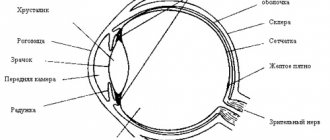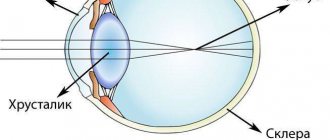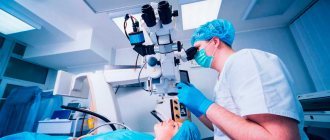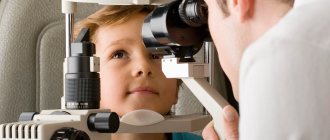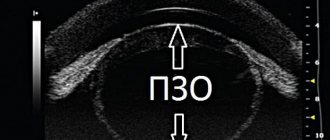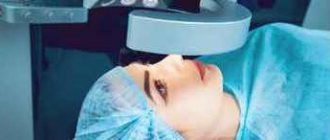Is poor distance vision myopia?
Myopia is a disorder of the refractive ability of the eye, in which a person can see nearby objects clearly and clearly, while distance vision
In this article
- Is poor distance vision myopia?
- Main causes of myopia
- Myopia - what is it like?
- Why is progressive myopia dangerous?
- How is myopia treated?
- Contact correction of myopia is convenient and discreet
- Laser correction - for those who want to see well without glasses and contacts
- Prevention of myopia: recommendations from experts
is blurry. In simple terms, a myopic person sees well up close but poorly at a distance. People with nearsightedness usually have no problem reading, knitting, or doing other activities close to their eyes. At the same time, it is difficult for people with this problem to read a store sign on the other side of the street or see the face of a person who is standing far from the observer without special correction means. According to statistics, myopia (another name for myopia) occurs in every third inhabitant of the Earth. Depending on the degree of the disease, it can significantly worsen the quality of life, greatly affecting vision, while in others it is almost invisible to the person himself. In any case, myopia has the ability to progress and, without proper correction, can lead to serious consequences, including critical vision loss. Therefore, as soon as you notice that your distance vision has become worse, you should immediately consult an ophthalmologist.
What causes myopia, is it possible to prevent or stop the development of the pathology, what means are used to correct myopic vision - we will try to answer these and other questions in detail.
Prevention
Compliance with preventive measures will reduce the likelihood of vision deterioration and will always allow you to see well both at a distance and at close distances:
- sufficient amount of vitamins in the diet;
- rejection of bad habits;
- good sleep;
- a break during visual work and performing eye exercises;
- work only in sufficient lighting;
- refusal to read while moving traffic;
- annual examination by an ophthalmologist.
If you notice that your distance vision has become difficult, do not put off visiting a doctor. The sooner you receive treatment, the better your quality of life will be.
In addition, you can see the top 5 eye massage methods to improve vision:
How good or bad is your distance vision? Share your feelings in the comments. Repost so that your loved ones know about the problem. Be healthy.
Main causes of myopia
Doctors identify two main causes of myopia:
- elongated eyeball;
- excessive refractive power of the eye.
Normally, the human eyeball has such a size and shape that the rays entering the eye are focused in the center of the retina. If the anteroposterior ocular axis is slightly longer than normal, the rays do not reach the retina and are focused in front of it. Due to the shifted optical focus, a person has difficulty seeing into the distance. If the length of the eyeball increases, myopia progresses and visual impairment becomes more pronounced. Sometimes myopia is caused not by the size of the ocular axis, but by the strong refractive ability of the cornea or lens. When the optical media of the eye refract light more than necessary, the focus of the image also shifts to the area in front of the retina and this is reflected in the clarity of distance vision.
Difference between diseases
The main distinguishing features of myopia and farsightedness are briefly presented in the table:
| Comparative criteria | Disease | |
| Myopia | Farsightedness | |
| Problems with visualizing objects located | In the distance | Up close |
| Pathological condition of the eyeball | Extended | Shortened |
| Lens curvature size | Increase | Decrease |
| Beam focusing | In front of the retina | Behind the retina |
| At what age does it occur? | More often in school | In old age |
What factors influence the development of myopia?
Despite the fact that there are only two main causes of myopia, there are many factors that contribute to the occurrence of this disease.
- Hereditary predisposition to an elongated eyeball or strong refractive ability of the eye. The highest probability of a child developing hereditary myopia exists when both of his parents have this pathology.
- Weakened scleral tissue and increased intraocular pressure (contribute to stretching of the eyeball).
- Reduced ability of the eye to focus at different distances (this impairment is compensated by an increase in the length of the eyeball).
- Weakened immunity - due to overwork, unbalanced nutrition, various diseases (curvature of the spine, flat feet, diphtheria and other infectious diseases, allergies, birth and other brain injuries, rickets, inflammatory diseases of the nasopharynx).
- Excessive visual stress - as a result of long work at the computer, reading in transport, poor lighting, incorrect sitting at the desk.
The listed factors can exist separately or complement each other. The more factors that affect a person, the higher the risk of developing myopia.
Myopia - what is it like?
Since there are many causes and factors contributing to the development of myopia, there are different types of myopia. Due to its occurrence, myopia is divided into the following types:
- axial (associated with an increased length of the anteroposterior axis of the eyeball);
- refractive (caused by excessive refractive power of the ocular media);
- mixed (in which both the size of the eyeball and the refraction of the eye optics are higher than normal);
- combined (dimensional and refractive indices of the eye are within normal limits, but are poorly combined).
Based on the time of occurrence, myopia is divided into congenital and acquired. In the first case, a child is born with a refractive error, in the second, myopia develops during life under the influence of external factors, visual stress, injuries, and diseases. The congenital form of myopia is less common than the acquired form, but is often accompanied by complications and abnormal development of the visual organs. The acquired form of the disease can be represented by both minor and more serious visual impairment. According to statistics, every year there are more and more people with acquired myopia.
According to the degree of development, myopia is divided into three types:
- weak (up to -3 diopters): a person with such a visual impairment sees distant objects a little blurry;
- medium (from -3.25 to -6 diopters): when it is difficult to see at a distance without glasses or contact lenses, but close objects can be clearly seen if they are no further than 30 cm from the face;
- high (from -6 diopters): with severe myopia, a person can see even closely located objects only when they are close to the face.
Pathological causes
Acquired farsightedness appears as a result of damage to the refractive system due to exposure to external factors. This can happen as a result of various reasons:
- Eye injuries. Forceful impact on the area of the lens can disrupt its shape, as well as impair the functioning of the muscles and nerves passing through here.
- Surgery on the lens or cornea of the eye. Despite good experience in performing ophthalmological operations, there is always a risk of consequences and complications.
- Neoplasm in the eye area. In this case, the tumor compresses the tissues of the eye. The lens changes its shape and the natural focusing of the eye is disrupted.
- Cataract. When the lens becomes cloudy, the likelihood of developing various ophthalmological pathologies, including farsightedness, increases.
- Diabetic retinopathy. In diabetes, there is a pathological formation of new blood vessels in the tissues of the eye. They are extremely fragile, brittle and are not able to maintain the functioning of the eye at the proper level.
- Incorrect process for correcting myopic disorders. The rapid progression of the disease is facilitated by the lack of proper treatment, which also includes constant wearing of glasses or contact lenses. This also includes incorrect selection of lenses, as a result of which, instead of a therapeutic effect, a person feels a deterioration in visual acuity.
Finally, a provocateur of farsightedness is a lack of nutritional components in the diet, in particular vitamin A. A large concentration of this component is in the retina of the eye. The lack of this photosensitive pigment leads to rapid aging of tissues and a decrease in the functionality of this area.
What symptoms may indicate myopia?
Myopia is a condition when a person can see objects close to him, but has difficulty seeing objects that are far away. Accordingly, the main symptom of the disorder is reduced distance vision.
But, in addition to this main symptom, other symptoms may indicate developing myopia:
- blurred image contours;
- increased eye fatigue;
- squinting when looking at distant objects;
- headaches, a feeling of tightness in the temporal zone and bridge of the nose, dizziness;
- “spots”, blind spots before the eyes, loss of visual fields (may be symptoms of complicated myopia);
- large eyeballs and wide pupils (a characteristic external sign for people with a high degree of myopia).
Symptoms
A disease such as hyperopia is characterized by a simultaneous deterioration in near vision and improvement in distance. The pathology provokes rapid fatigue due to constant tension in the eye muscles, resulting in frequent headaches. Additionally, the general functions of the eyeball are reduced, the so-called “lazy eye” syndrome. After prolonged overexertion, burning and itching occurs. If you do not consult an ophthalmologist in the presence of such symptoms, the intensity of the discomfort will increase and visual acuity will decrease.
Why is progressive myopia dangerous?
If myopia progresses, it poses a serious threat to vision. Stretching of the eyeball becomes pathological, leading not only to a decrease in visual acuity by more than one diopter annually, but also to disruption of the nutrition of the eye tissues, ruptures, detachments and degenerations of the retina, and opacification of the vitreous body. With complicated progressive myopia, a person sees worse and worse, and any hard work or sudden movement can lead to damage to the retina and, as a result, a sharp fall or complete loss of vision.
That is why one of the most important tasks of ophthalmology is the stabilization of myopia.
How is myopia treated?
Despite the fact that myopia is a widespread phenomenon and affects more than 1 billion people around the world, today there are no treatment methods that could restore the eye to normal refraction with a 100% probability. The methods used in the treatment of myopia are aimed at solving several main problems:
- vision correction;
- stabilization of myopia (stopping or slowing down its progressive development);
- elimination of factors that contributed to the onset of the disease.
The choice of therapy depends on the cause, degree of myopia, patient's age and other factors. The ophthalmologist decides which treatment regimen will be effective in each specific case. All methods of combating myopia can be divided into several groups.
- Medicines (mainly affecting the functioning of the accommodative apparatus and reducing intraocular pressure).
- Vision correction with glasses, soft or orthokeratological lenses.
- Hardware techniques.
- Surgical treatment (scleroplasty, lens replacement, phakic lenses).
The development of myopia often begins in childhood, so the most important role in combating this problem is played by disease prevention, timely diagnosis and early treatment in children.
Drug treatment of myopia - strictly as prescribed by the doctor
Medicines in the treatment of myopia are used infrequently and strictly as prescribed by the doctor.
When indicated, ophthalmologists sometimes prescribe atropine, which can slow the progression of myopia in children. However, experts still do not have complete data on the possible side effects of long-term use of this drug, so it is prescribed in rare cases.
In addition to atropine, tropicamide, which relaxes the ciliary muscle and blocks accommodation, can be used in the complex treatment of myopia. Sometimes doctors prescribe antihypertensive medications, believing that increased pressure inside the eyes can worsen myopia. However, at the moment, ophthalmologists have little evidence of the relationship between increased IOP and the progression of myopia, so many doctors consider it inappropriate to prescribe such treatment to patients.
Who undergoes scleroplasty?
This method refers to surgical methods for treating progressive myopia. As a rule, it is prescribed to adult patients when the level of eye refraction exceeds -6 diopters. The main goal of the operation, which is performed under local anesthesia and takes about 15-20 minutes, is to strengthen the outer layer of the eye (sclera) to prevent further increase in the length of the eyeball and deterioration of distance vision. Doctors note that scleroplasty, in addition to strengthening the eye shell, has another positive effect - it helps to increase the number of vessels through which nutrition flows to the posterior pole of the eye, and thus improves its blood supply. During scleroplasty, the ophthalmic surgeon inserts special implants into the sclera through microscopic incisions, which form a frame that prevents stretching. You should not expect that after scleroplasty a person will be able to see well into the distance. But this procedure will stop further vision loss by fixing the refraction values at the level they were before surgery. To restore visual function, optical or laser correction will be required.
What to do?
Preparations and optics
With the help of broccoli and Brussels sprouts, you can enrich your body with lutein.
With age, the production of lutein and zeaxanthin in the body is disrupted, which leads to a decrease in near visual acuity. To compensate for their deficiency, it is necessary to eat foods that contain large amounts of these substances, for example, curly or Brussels sprouts, spinach, broccoli. It is recommended to increase your intake of vitamin C, E, zinc and selenium. The doctor prescribes the multi-vinamine complex “Okuwite Lutein Forte” or “Lutein Complex”, which can compensate for the deficiency of components artificially. After an ophthalmologist has diagnosed the fundus of the eye, the doctor determines the necessary diopters for the lenses so that they can remove the discomfort. It is not recommended to select it yourself, as it can cause irreparable harm to health.
Surgery
When conservative methods are not effective, doctors perform the following surgical interventions:
- Laser correction.
- Thermokeratoplasty. Using thermal radio waves, the shape of the cornea and its refractive properties are changed.
- Lensectomy. An artificial implant is placed instead of a biological lens.
- Keratoplasty. Removal of the affected cornea.
- Lens implantation, in which the organ is not removed, but the optics are placed in front of the lens.
- Radial keratotomy. Changing the refractive power of the cornea using notches.
- Thermokeratocoagulation. Point correction of the fundus with a heated needle.
Exercises
A positive effect can be obtained by looking around, up and down.
- With your eyes closed, open your eyelids tightly. Repeat 10 times at 30 second intervals.
- Look up, down, right and left, without moving your head three times. Then repeat only with closed eyelids.
- Rotate your eyeballs in a circle, first with your eyes open, and then close your eyes. Do 5 reps after a minute.
- Close and open your eyelids at high speed for 60 seconds.
- Having found a spot or point on the window glass, alternately look into the distance at some object that can be clearly seen back. Do the exercise 10 times.
Glasses will help you see near and far equally well.
One of the popular methods of vision correction for myopia and the most common in children is glasses. The principle of their operation is based on reducing the refractive power of the eye to such values that the focusing of light rays falls exactly on the retina. Myopia glasses have negative power lenses that help shift the focus to the retina, allowing the eyes to see far and near with equally good clarity. Often, a patient is diagnosed with astigmatism along with myopia. In this case, ordinary monofocal glasses will not be able to restore the necessary clarity of vision; special astigmatic models with “cylinder” lenses will be required. For myopia, the doctor may prescribe glasses for constant or periodic wearing, depending on the goals of correction, the degree of myopia, the patient’s age and other factors.
The main advantage of spectacle correction for myopia is its versatility, ease of use, and accessibility for people of any age and occupation. However, not everyone likes how glasses change their appearance, and teenagers may even be ashamed of their “bespectacled” image and refuse the necessary correction. In this case, you should consult your doctor about the possibility of switching to contact lenses.
What diseases are difficult to see up close?
Poor near vision is not always a physiological cause. Often it indicates pathological factors. The main causes of poor near vision are:
- Cataract. A common disease that is clouding of the lens. Older people are susceptible to it. Blurry visual perception will first manifest itself up close as difficulty reading. Gradually, the clinical picture worsens, photosensitivity and changes in color perception appear.
- Retinal detachment. It involves the detachment of the retina from the wall of the eye to which it is attached. Before this, a person may have good vision, he does not have any complaints. Retinal detachment is determined by narrowing of the visual fields, deterioration of near vision, veils and spots before the eyes. Separation of the retina from the choroid is a serious problem requiring immediate surgical intervention.
- Retinal tear. In this condition, there is a decrease in the quality of vision. The transmission of signals to the brain is disrupted due to damage to the thin membrane. The degree of visual impairment varies depending on the size of the retinal tear.
- Retinopathy. Develops against the background of diabetes mellitus due to the formation of plaques on blood vessels. Near vision is blurred, spots appear before the eyes. Reduced visual perception indicates a severe course of the disease. Retinal or vitreous hemorrhage is possible.
- Dystrophic processes. This is a common cause of progressive vision loss. Dystrophy develops in the cornea and retina. Caused by inflammatory and traumatic damage to the ocular structures.
Contact correction of myopia is convenient and discreet
Today, contact optics are in great demand, and the choice of soft optical lenses for correcting myopia is quite large.
Contact lenses operate on the same principle as glasses, that is, due to the “minus” in diopters, they move the focal point onto the retina.
But, compared to spectacle correction, contact correction has several advantages:
- does not produce peripheral image distortion;
- eliminates the possibility of eye injury if the product is damaged;
- invisible to prying eyes and does not affect appearance;
- allows you to lead an active lifestyle without regard to vision problems.
Modern contact lenses not only correct myopia, farsightedness and other refractive problems well. They are manufactured using technologies that make them easy to wear, comfortable and safe for the eyes. Popular contact lens models that are often prescribed to correct myopia include ACUVUE Oasys, Dailies AquaComfort Plus, Biofinity and others.
Treatment methods
The sooner the patient begins treatment for this disease, the greater the chance of a successful recovery without consequences. In addition to the main two areas of treatment for farsightedness (wearing glasses or contact lenses and surgery), there are other ways to improve the condition of eye tissue. Thus, drug therapy for farsightedness is practically not used today, but the patient can be prescribed drops to alleviate the condition and relieve symptoms. There are also physiotherapeutic methods for treating farsightedness: laser and magnetic therapy, electrophoresis, etc.
And of course, if the patient has related pathologies or other diseases that caused farsightedness, then it is necessary to contact an appropriate specialist for their treatment.
Eye exercises
With the help of special exercises, metabolic processes in the tissues of the eye can be significantly improved. It is especially indicated for people with mild presbyopia. Such gymnastics must be performed several times a day, and when working with documents - every 40-50 minutes. Here are just a few exercises:
- Look straight ahead. Now slowly turn your head to the left, following it with your gaze. Repeat for the right side.
- Focus your gaze on the most distant point (for example, in a window) and look at it for 30 seconds. Now extend your hand, raise your finger and look at its tip for another 30 seconds.
- Look at an object in the distance, and then move your gaze to your nose.
The doctor may also recommend exercises to restore blood circulation in the cervical spine. This area is extremely important for the normal functioning of the organs located above.
Conservative therapy
It traditionally involves wearing glasses or contact lenses. Actually, this is not even a treatment, but a correction of existing disorders. The correction is temporary, that is, only for as long as the patient wears glasses or contacts. Without wearing these optical correction devices, the disease will progress.
Surgical treatment
The surgical method is the most progressive today. Modern medicine offers several types of operations to eliminate farsightedness. The most popular is laser vision correction by correcting the shape of the lens. This laser intervention can eliminate disorders of up to +4 diopters. Today there is another way to give the necessary shape to the lens - thermokeratoplasty. This operation uses the heat of low energy radio waves.
For higher degrees of farsightedness, the patient may be offered phakic lens implantation. Essentially, the lens needed to view close objects is now always with the patient. It is also possible to completely replace the lens, especially if a person becomes unable to see clearly due to problems with the transparency of the lens (there is a possibility of developing cataracts).
Orthokeratology lenses - night vision correction
Night lenses, otherwise called orthokeratological lenses, are an option for those who, for one reason or another, are not suitable for conventional contact lenses. Such products should be used during sleep and removed during the day. Overnight, an orthokeratology lens changes the shape of the cornea so that light rays begin to fall directly on the retina. Having removed optical products in the morning, a person can see clearly both near and far. This effect lasts for several hours, so during the day the user sees clearly without any means of optical correction. By evening, the cornea takes on its original shape, so at night it is necessary to wear orthokeratology lenses again.
Hardware techniques - safe treatment of myopia in childhood
When a child has difficulty seeing distant objects, along with optical vision correction, the doctor may prescribe hardware treatment to improve the functions and condition of the visual system.
Infrared laser therapy.
The eyes are exposed to infrared radiation, which helps normalize metabolism and relieve spasm of accommodation.
Vacuum massage.
The procedure helps improve the hydrodynamics of the visual organs, blood supply, and normalizes the functioning of the ciliary muscle.
Electrical stimulation.
The child’s visual organs are exposed to low-intensity current, which improves the conduction of signals in the optic nerve. When necessary, the doctor may prescribe other hardware techniques. This is, for example, laser therapy or special video-computer training.
Laser correction - for those who want to see well without glasses and contacts
Today there are several methods of laser correction of myopia. They are united by a common principle of execution. Using a laser beam under the control of modern high-precision equipment, an ophthalmologist changes the shape of the cornea according to a person’s individual parameters. This allows you to achieve correct refraction and see clearly without the use of aids.
Diagnostics
The primary step in diagnosing the disease is checking vision using tables and tests. Myopia and farsightedness are characterized by significant impairment of visual function. Therefore, if a person is concerned about the characteristic symptoms of one of the diseases, it is necessary to visit an ophthalmologist and undergo a comprehensive diagnosis. During the initial examination, the degree of vision is determined using a special table. If the patient sees the bottom row with letters poorly, it means that he is developing myopia, and when, on the contrary, the bottom rows are visualized, but the top ones are not, a preliminary diagnosis is made - farsightedness. To distinguish other symptoms, as well as to find out the plus or minus of vision, the following additional diagnostic tests are prescribed:
- visometry;
- ophthalmoscopy;
- fundus examination;
- Ultrasound, CT or MRI of the visual system.
